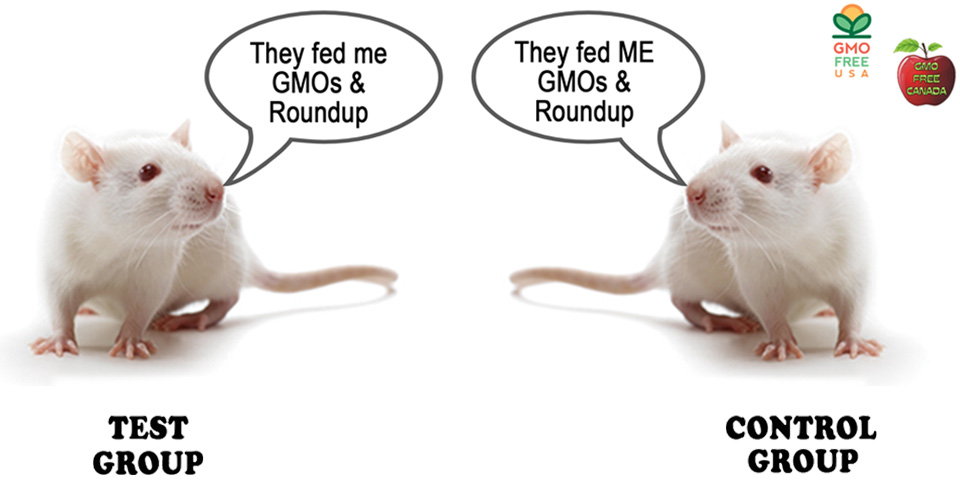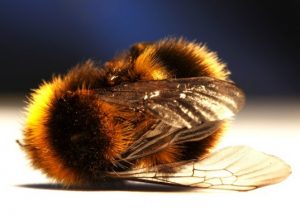Part 3 – What We’re Beginning to Learn
When I made my original Facebook post last summer, fueled by the suggestion that I use Roundup in my garden, most of the information I found was tied to the original 2015 report from the International Agency for Research on Cancer, which concluded that glyphosate is “probably carcinogenic to humans” and the EPA’s Cancer Assessment Review Committee (CARC) 2016 response that “glyphosate was ‘not likely to be carcinogenic to humans’ at doses relevant to human health.”
At that point, there was not much more that I was 1) able to find in an afternoon of angry Googling, and 2) willing to use as a marginally-reputable source to support my argument. Since then, a lot more information has come on the scene, both in the form of court cases against Monsanto (four held to date out of over 11,000 filed) and new scientific studies about the effects of glyphosate on living creatures.

Image credit:[1]
Scientific Studies on Cancer
According to an NPR piece[2] on the subject earlier this year, there are three major types of studies that link glyphosate to danger for humans:
- DNA damage in cells exposed to glyphosate in lab settings (cell mutations are the first step in causing cancer)
- Mice developing tumors after being fed glyphosate
- Real-world accounts of exposure to glyphosate and subsequent diagnosis of non-Hodgkin lymphoma (or other complications).
The US Right to Know[3] website has the most comprehensive list that I have seen on studies that demonstrate varying levels of connection between glyphosate and danger to humans. Here are some examples from that list:
A number of recent studies include links between glyphosate and shortened pregnancy lengths (women in Indiana)[4], miscarriage and congenital abnormalities (women in agricultural areas in Argentina)[5], and damage to DNA in human embryonic, placental, and umbilical cord cells in the lab.[6] On top of that, there are other concerns around endocrine disruption,[7] non-alcoholic fatty liver disease,[8] and birth defects and reproductive problems in lab animals.[9],[10] There appear to be links to “increases in obesity, reproductive and kidney diseases, and other problems in the second- and third-generation offspring of rats exposed to glyphosate.”[11]
It has been consistently hard for any of these studies to gain mainstream traction, however. In one example, a recent CNN article covered a study[12] released by the University of Washington, stating that “glyphosate, an herbicide that remains the world’s most ubiquitous weed killer, raises the cancer risk of those exposed to it by 41%.” A response from Francis Martin, biosciences professor at the University of Central Lancashire, said that he “welcomed the University of Washington report. … However, he noted that the report was limited by the small number of existing studies on the subject, though he stressed that the authors were ‘honestly self-reflective on the limitations of the analyses.’ … ‘[The report] highlights the need for new, well-designed and robust studies at appropriate exposures levels,’ Martin said, adding, ‘The number of robust studies in the literature examining this question is pathetically small.’”[13]
There are over 3,300 peer-reviewed studies on glyphosate, but many of the ones that question the chemical’s safety come under criticism for being too small to demonstrate causation, not correlation. In addition to small sample size, I have also seen rebuttals that these studies examine unrealistic amounts of exposure that would not be encountered in nature (e.g. injection of glyphosate directly into an embryonic cell in the lab). Finally, many of these studies have been accused of not having enough academic rigor, specifically the Argentinian studies, which were conducted in locations where other untested/unregulated chemicals were in use simultaneously, meaning that the specific impact of glyphosate could not be determined.[14]
Ultimately, supporters of glyphosate maintain that the level of exposure is so small in residential applications that it poses no risk to the average home gardener doing battle with weeds, using Roundup as directed.

Image credit:[15]
Scientific Studies on Gut Bacteria
Home applications are one thing, but commercial use of Roundup continues to boom all over the globe. Concern is on the rise about the amount of glyphosate that makes it into our food. I know parents who have stopped buying certain foods for their children because of the high levels of glyphosate used on the crops, specifically corn, wheat, and soy.
Again from US Right to Know: in addition to using Roundup as an herbicide to kill weeds that compete with crops, “some farmers use glyphosate on non-GMO crops such as wheat, barley, oats, and lentils to dry down the crop ahead of harvest in order to accelerate the harvest. This practice, known as desiccation, may be a significant source of dietary exposure to glyphosate.”
The government says the levels detected in food are in small enough quantities that they pose little to no health risks. However, while both the USDA and FDA “have programs that annually test foods for pesticide residues, … both have routinely skipped testing for glyphosate.” The FDA ran a short-lived testing program in 2016, and during that time found glyphosate in US honey[16] (which has no allowable level set by the EPA). Levels were also detected in corn, soybeans, oatmeal, and baby food, as well as popular name-brand cereals, cookies, and crackers. Internal FDA emails indicated the “FDA has had trouble finding any food that does not carry traces” of glyphosate.[17]
The cancer connection has been in question for years, but more recently scientists are seeing an impact on gut bacteria. The microbiome that breaks down our food is directly tied to our physical and mental health – that connection has been established.[18] What we are just beginning to learn is how glyphosate impacts our gut flora.
Glyphosate was developed to work by blocking an enzyme (“EPSP Synthase”) that is needed to create amino acids. This enzyme and its corresponding pathway exist in plant cells, not animal cells – and that is one of the main arguments used to deny any connection with harm to humans or other animals. However, that pathway also exists in some microorganisms, including some gut bacteria, and those impacts have been studied in rats and – wait for it – bees.
From the journal Toxicology Reports[19] we see that disruption of the gut microbiome “induced by environmental pollutants, such as pesticides, could have a role in the development of metabolic disorders.” This study specifically looks at connections on rat gut microbiota and health disorders. “These gut microbiome disturbances showed a substantial overlap with those associated with liver dysfunction in other studies.”
Research indicated connections between gut bacteria health and clinical conditions in the same system, such as inflammatory bowel disease and colorectal cancer, as well as in other systems, including diabetes, obesity, asthma, liver and cardiovascular diseases, and even autism spectrum disorder. “A number of studies have indicated that changes in dietary patterns and lifestyle, as well as the presence of toxic food contaminants, can modulate the composition and the activity of the gut microbiome even if their role in the development of this disease is still poorly understood.”
The aforementioned study drew a connection between gut microbiome and health, while others look specifically at the effects of glyphosate on gut microbiota, concluding that it kills beneficial gut bacteria in rats, causing anxiety and depression-like behaviors.[20],[21]

Image credit:[22]
Impacts on Bees
As for studies on bees, the National Academy of Sciences[23] stated in October 2018 that “exposing bees to glyphosate alters the bee gut community and increases susceptibility to infection by opportunistic pathogens.” They hope that better understanding the connection between glyphosate and bee gut health will shed light on a possible connection between the use of glyphosate and bee colony collapse.
The bee gut flora helps bees maintain weight and fight off pathogens. In experiments, bees were exposed to glyphosate at concentrations they might encounter in the environment, based on documented levels. Young worker bees were exposed first to glyphosate and then to an opportunistic pathogen. NAS concluded that exposure of their bees to glyphosate “can perturb their beneficial gut microbiota, potentially affecting bee health and their effectiveness as pollinators.”
Chemical & Engineering News[24] followed up to the NAS study agreeing that “honeybees with compromised gut flora are malnourished and susceptible to infection. Those findings, along with data showing that glyphosate can affect soil bacteria and accumulate in bee honey and hives, indicate that researchers should explore whether possible off-target effects of the popular herbicide have played a role in honey bee decline.”… They explain that “glyphosate doesn’t kill microbes, but it keeps them from growing, and most bacteria found in bee guts carry the gene for the enzyme.” Furthermore, we know from the FDA study on honey, mentioned above, that bees were ingesting the chemical.
The debate rages on, with objectivity and scientific rigor being called into question with each new study. Roundup may not give me cancer if I spray it on my driveway, but as long as there is a possible connection between glyphosate use and bee colony collapse, I will not be using it in my yard.
What do you think? Has any of this information changed your opinion either way? Tune in next week as we weigh alternatives and ask if there is a better option.
Thanks for reading!
[1] https://www.canr.msu.edu/news/horseweed_confirmed_resistant_to_glyphosate_in_michigan_field_crops
[2] https://www.npr.org/sections/thesalt/2019/05/30/727914874/safe-or-scary-the-shifting-reputation-of-glyphosate-aka-roundup
[3] https://usrtk.org/pesticides/glyphosate-health-concerns/
[4] https://ehjournal.biomedcentral.com/articles/10.1186/s12940-018-0367-0
[5] http://file.scirp.org/Html/4-6703530_83267.htm
[6] https://www.ncbi.nlm.nih.gov/pubmed/19105591
[7] https://www.ncbi.nlm.nih.gov/pubmed/19539684
[8] https://www.nature.com/articles/srep39328
[9] https://www.ncbi.nlm.nih.gov/pmc/articles/PMC4895883/
[10] https://link.springer.com/article/10.1007/s00204-018-2236-6
[11] https://www.nature.com/articles/s41598-019-42860-0
[12] https://www.sciencedirect.com/science/article/pii/S1383574218300887
[13] https://www.cnn.com/2019/02/14/health/us-glyphosate-cancer-study-scli-intl/index.html
[14] http://fafdl.org/blog/2017/12/04/conspiracy-theories-about-glyphosate/
[15] https://www.gmwatch.org/en/news/latest-news/16242-laboratory-rat-feeds-contaminated-with-toxic-pesticides-and-gmos
[16] https://www.huffpost.com/entry/fda-finds-monsantos-weed_b_12008680?guccounter=1&guce_referrer=aHR0cHM6Ly91c3J0ay5vcmcvcGVzdGljaWRlcy9nbHlwaG9zYXRlLWhlYWx0aC1jb25jZXJucy8&guce_referrer_sig=AQAAACu1uvCyjwhnh0WRByWBgYv4bAB_Wj2eISYyDID4Hrn7IthARw_7fPJtkjAqk2bYN21hcALzK5Swr6K3-Nb5C15uP7ceie_9f-NjOvkc0ULqa492732rOJkrnqmZVJFtdp9FI925L-dYV8ufeFIzd9JMV1oETVshu1M2TuXc6XUg
[17] https://www.theguardian.com/us-news/2018/apr/30/fda-weedkiller-glyphosate-in-food-internal-emails
[18] https://www.wnycstudios.org/story/197242-gut-feelings
[19] https://www.sciencedirect.com/science/article/pii/S2214750017301129
[20] https://www.nature.com/articles/npjbiofilms20163
[21] https://www.sciencedirect.com/science/article/pii/S0892036218300254
[22] https://anh-usa.org/pesticides-definitively-linked-to-bee-colony-collapse/
[23] https://www.pnas.org/content/115/41/10305
[24] https://cen.acs.org/environment/pesticides/Glyphosate-disrupts-honey-bee-gut/96/web/2018/09
0 Comments